The shipping industry at large and the LPG tanker segment in particular experience increased focus on hull integrity (maintenance) – for safety reasons and for cost efficiency. Requirements for CAP and TMSA compliance are important in order to obtain acceptance by charterers. Transparency and continuous control of a ship’s hull condition may therefore create business advantages to ship operators and owners.
Summary
DNV’s Hull Integrity Management (HIM) is a practical concept developed for this purpose. It has been developed over a period of six years. It helps owners and operators to keep their ship’s hull fit for purpose through continuous control of the hull condition, which both reduce the maintenance costs and may create business advantage.

HIM empowers the ship officers to take a more active role in assessing the hull condition. It guides them where to look and what to look for during regular on board inspections. HIM thus helps to detect defects early on and to deal with them while they are small. HIM is based on DNV’s extensive hull expertise but is not a class requirement, and therefore applies to vessels classed by any class society.
Introduction
The seaborne transport of liquefied gases in bulk is older than often realised. Already in 1949 the first dedicated liquefied gas carrier with fully pressurised cargo tanks was delivered with DNV class. Therefore, DNV became involved very early in the setting of safety standards for these types of vessels, and was the first classification society to publish comprehensive rules for gas carriers in 1962.
Today hull and cargo tanks construction are the only areas exclusively covered by classification standards. In all the other areas the Convention requirements (“IMO Gas carrier Code”) form the framework within which classification standards have been developed.
The main hazards for liquefied gas transport are:
- high pressure,
- low temperature,
- flammability,
- toxicity,
- reactivity.
Cracks, corrosion, and other elements of structural integrity are also of main areas of attention. Lack of satisfactory hull integrity may have basic negative consequences. This is also the reason why hull integrity receives such strong attention from charterers in connection with vetting.
Excellent control of hull integrity is a hallmark of quality shipping.
This paper first elaborates on some important design issues that will have impact on safe operation of LPG carriers. Thereafter, the main topic for the paper is how DNV’s Hull Integrity Management (HIM) is a practical concept that helps LPG operators to keep their ship’s hull fit for purpose through continuous control of the hull condition, thereby creating business advantages and reducing maintenance costs.
Characteristics of LPG Carriers
Gas tankers are ships carrying cargo of liquefied gas which has a minimum pressure of 2,8 bar absolute at 37,8 °C.
At temperatures below its critical temperature the gas may be carried in the liquid state at the pressure corresponding to its vapour pressure at the carriage temperature. Above its critical temperature the gas cannot enter into the liquid state, regardless of pressure.
When transporting gases having a critical temperature above the ambient temperature, one thus has the following possibilities of carriage:
- “Fully pressurised” at ambient temperature.
- Cooled to a temperature between ambient and the boiling temperature of the gas at atmospheric pressure; i. e. “semi-refrigerated” or “semi-pressurised”.
- “Fully refrigerated” at near atmospheric pressure.
The liquefied petroleum gases, LPG, anhydrous ammonia, NH3, and vinyl chloride monomer, VCM, do all have critical temperatures above the ambient and may be carried fully pressurised or refrigerated.
Cargo containment types
For the transportation of LPG and chemical gases (VCM, NH3 and volatile chemicals) there are in practice two alternatives:
- Pressure vessel type tanks: (Defined as Cargo Tanks Type C).
- Independent prismatic tanks: (Defined as Cargo Tanks Type A).
Cargo Tanks Type C
Normally these tanks are insulated and fitted with a refrigeration plant. However, tanks with no insulation and no refrigeration are possible, provided the design pressure is at least equal to the vapour pressure of the cargo at a temperature of 45 °C. For pure propane this corresponds to about 14,8 bar above atmospheric.
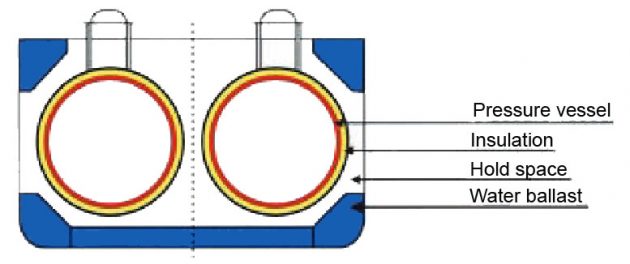
Commercial propane containing small fractions of ethane has higher pressure dependent on the ethane content. Design pressure for propane tanks without refrigeration is usually 17,0 – 18,0 bar gauge. The pressure of NH3 at 45 °C is 16,8 bar gauge.
Cargo Tanks Type A
These tanks will always have to be insulated and fitted with refrigeration capable of maintaining the cargo near atmospheric pressure, see Figure 2.
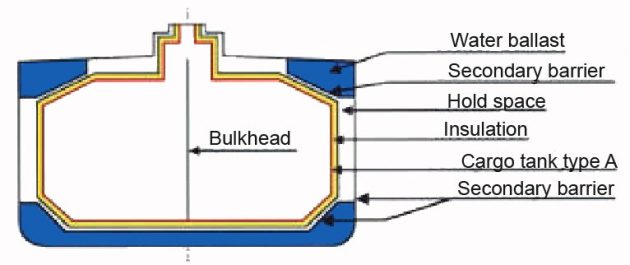
On some of the first vessels built with cargo tank type A it was normal to fit the insulation on the secondary barrier (the inner hull). Now, the normal way is to fit the insulation on the cargo tanks.
Design of cargo tanks
The choice between pressure vessel type tanks and prismatic type tanks depends on economical, technical and operational considerations. Generally the former are used for capacities up to some 20 000 m3, the latter for vessels above that size, where the number of pressure vessel tanks required adds significantly to the building cost.
For the prismatic type cargo tanks a secondary barrier (i. e. emergency cargo containment) is required, which means that the material of the hull or inner hull must be of low temperature quality.
This is not required for pressure vessel type C cargo tanks.
The type C cargo tanks do also allow loading of cargo at higher pressures, i. e. higher temperatures, and this may be a considerable advantage if the ship is loading at terminals where shore storage tanks are of the pressure type.
The design parameters of the cargo tanks are determined mainly by the boiling temperatures and the density of the intended cargoes. The design temperature is decisive for the choice of tank material and the cargo density for the scantlings of the tanks and its support. In addition, the design pressure is an important parameter although not influenced by the type of cargo except in the case of fully pressurised tanks.
In the later years the need for fully pressurised LPG vessels has increased in certain trades. Contrary to the original design of such ships which were fitted with a number of smaller pressure vessel type tanks, these ships are today often designed with only 2 or 3 large cylindrical tanks.
In order to limit the tank thickness, high tensile steels have been used. Such steels are not covered by the IMO Code and the use raises some technical challenges which must be dealt with by the classification society. These technical challenges are among others to determine maximum acceptable thickness, impact values dependent on thickness and if post weld heat treatment or mechanical stress relief should be required.
Summary of design considerations
By comparing the properties of the various cargoes, one will see that:
- A pure LPG carrier must have tank material suitable for a temperature of -48 °C. Carbon-manganese steel is the natural choice for tank material. A design density of 0,61 t/m3 will enable carriage of all LPG’s.
- A LPG/ammonia carrier has the same design parameters as a LPG carrier, except that the design density has to be increased to 0,68. However, if the vessel also is intended for chemical gases (VCM, acetaldehyde etc.), the design density must be at least 0,97 t/m3.
- A LPG/ethylene carrier must have tank material suitable for minimum temperature of -104 °C. This means that 5 % Ni-steel is the minimum quality.
Design for Increased Lifespan
LPG ships are designed by utilising:
- Extensive computerised stress analysis.
- Application of fracture mechanics.
- Application of programs for quality assurance and quality control during construction.
For the cargo tanks itself small dynamic loads will occur and when occurring mainly from only one side, resulting in very limited Fatigue Analysis Methodology and Damage Calculations of Structural Details specific to the VLGSfatigue problems.
Taking into account that the cost of cargo containment may be in the range of 40 % of total cost for the vessel, it might be economical to upgrade the ship itself to increase the lifespan. This will to a great extent normally require steel renewals. Ballast tanks are normally exposed to corrosion. Some upgrading of pumps, navigation equipment etc. may also be necessary.
In-service follow up – class
In order to maintain a valid Class Certificate and a Gas Carrier Code Certificate of Fitness, the vessel must be subjected to periodical surveys as follows:
- The annual survey (1 year ± 3 months) is a general examination of a ship and its equipment which include operational tests of the vessel’s systems and equipment to the extent necessary to confirm that the vessel and its equipment remain satisfactory for the service for which the vessel is intended.
- The intermediate survey (2,5 years ± 6 months) is to supplement the annual survey by testing cargo handling installations with related automatic control, alarm and safety systems for correct functioning.
- The complete periodical survey (max. 5 years) is a thorough and complete examination of cargo containment systems and all other cargo related systems.
The survey which has caused most concern in the past is the class renewal survey of pressure vessel type C tanks.
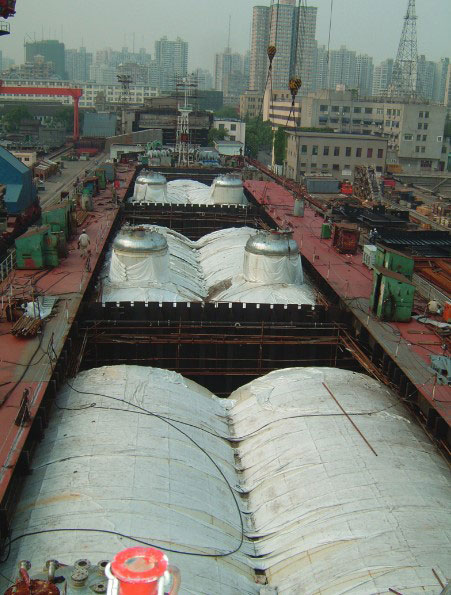
Traditionally, pressure tanks have been required to be hydraulically tested according to pressure vessel codes and class rules. This is a very undesirable test for gas carriers because the water can be very difficult to remove completely and may cause problems by freezing of valves and equipment when the vessel returns to service.
As the purpose of the test is to reveal leakages and cracks in the tanks, it has been realised that thorough non-destructive testing, NDT, and a tightness test is an equally good testing procedure. According to new rules worked out by IACS, the owner has now the option to choose between hydraulic testing and NDT. The NDT shall cover a certain percentage of the areas defined as highly stressed. For the tightness testing it is acceptable to utilise the gas detection equipment at the first loading after the survey. If the alternative using NDT is chosen, the test should be well planned and it is recommended that the extent is agreed with the class society before-hand in order to prevent undue delay.
In-service follow up – owner
The experienced owners of gas carriers normally carry out:
- Extensive and systematic training programs for crew and officers.
- Benefit package for the on-board personnel to minimise turnover and ensure a stable and well qualified manning for safe and economically sound operation. The resulting accumulation of knowledge and operational experience is a valuable asset in this respect.
- Procedures specified and adhered to for all important operations.
The above operational aspect is contributing to the documented fact that gas tankers have for many years had less detentions from port state control in Europe compared with other ship types.
Hull integrity management
The main hazards for liquefied gas transport are:
- high pressure,
- low temperature,
- flammability,
- toxicity,
- reactivity.
Cracks, corrosion, and other elements of structural integrity are also of main areas of attention.
Regarding the cargo containment system itself, gas carriers have a good record in terms of safety. This shows that the classification standards and system of work have been capable of achieving the goal of safeguarding life, property and the environment. The role of the classification society as a resource and competence centre is perhaps of equal importance as the classification services.
Read also: Cargo Containment Systems of LPG and LNG
Still, damage statistics clearly show that also the gas carriers suffer from the same challenges as other tankers when it comes to structural integrity of the hull itself. Especially, corrosion has been a challenge on LPG carriers. Satisfactory hull integrity may have basic negative consequences. This is also the reason why hull integrity receives such strong attention from charterers in connection with vetting. Excellent control of hull integrity is a hallmark of quality shipping.
DNV’s Hull Integrity Management (HIM) is a practical concept developed over a period of six years. It is an aid to owners and operators in their in-service follow up and in keeping their ships’ hull fit for purpose through continuous control of the hull condition. This may create business advantages and reduce the maintenance costs at the same time.
HIM consists of four service elements:
- Hull Competence courses, focusing on:
- basic strength,
- ship-type specific structural defects and hull inspection for ship officers and superintendents.
- Hull Inspection Manuals, ship- and company-specific and with unique 3D illustrations which identify what to look for during inspections, where to look and how to report it.
- Nauticus Hull Integrity software, easy-to-use web-based software for planned inspection and maintenance and with unique 3D technology for easy visualisation and understanding.
- Hull Advisory Services, detailed assistance and sophisticated calculation tools for use in connection with repairs and docking.
Each of the four service elements individually has a proven track record, and the total concept has over the last year proved the added value of combining these elements. They may be used one by one, combined step-wise or form part of a holistic approach to hull maintenance. All the services are based on DNV’s extensive hull expertise but are not a class requirement, and therefore apply to vessels classed by any class society.
Hull competence
The technical department in ship owner’s organisation has in many cases been reduced in order to cut cost. A general perception is that the competence in a typical technical department is strongest with respect to machinery and systems compared to hull and structure.
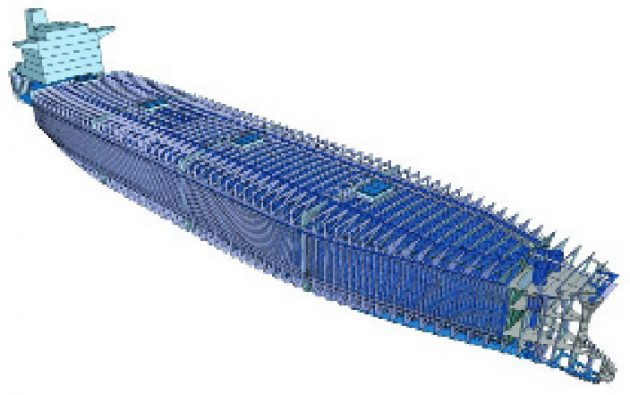
In order to meet the needs for more structural expertise, technical experts on hull structure in DNV have developed a set of Hull Competence Courses:
- Hull Structure Course, Ship-type specific 2 days training course which gives superintendents and technical staff a better understanding of ship structures. The participants are introduced to the basic strength theory, structural defects and tank inspections.
- Hull Inspection Course, practical 1-day training for the on-board ship officers. Empowers them through giving them the skills they need to carry out tank inspections – where to look and what to look for. The course covers a brief introduction to strength theory, but focuses more on where to look for defects, types of structural failure, coating assessment, corrosion assessment and reporting of deficiencies.
Hull structure course
The objective of this course is to give the participants increased understanding of the structural configuration and response of ship structures, thereby improving the quality of hull inspections and provide a sound basis for evaluating the criticality of structural defects. Hence, the training will contribute to improve the owner’s hull inspections, and the ability to evaluate the criticality of structural defects.
A key element in this course is to build an understanding of the strength response of a beam subject to different loads and end fixations. This is done generic for all ship types, see Figure 5.
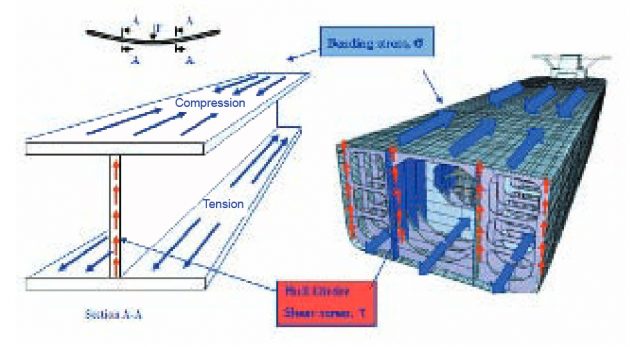
The training also goes into depth with regard to different failure modes such as corrosion, cracks, buckling and indents. This builds a generic strength approach which is then applied to the specific ship type in question.
Prior to attending the classroom course, the participants are invited to take part in a web primer, for some a chance to brush up on well-known facts and for others a good opportunity to get a head start on what they are about to learn for the first time.
The one-day, ship-type-specific module goes into more detail on the build-up and function of the hull structure, and more on the function of each structural component, see Figure 6.
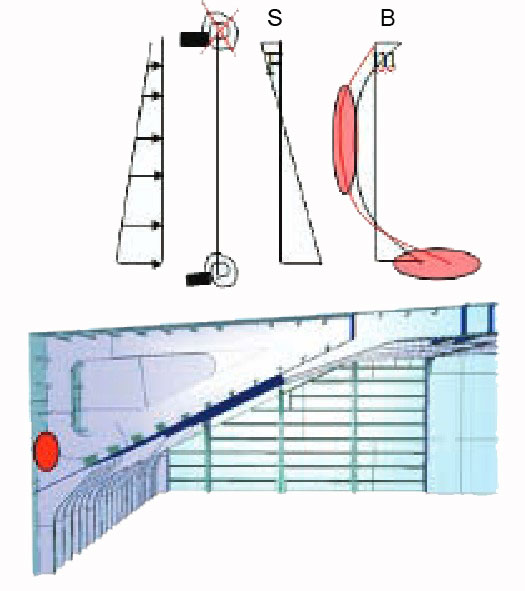
It also elaborates and discusses the causes of typical damages for the specific ship type, the cause of damages, the consequence of damages and the impact they will have on the ship’s strength response. Finally, the training also discusses and illustrates proposed repairs.
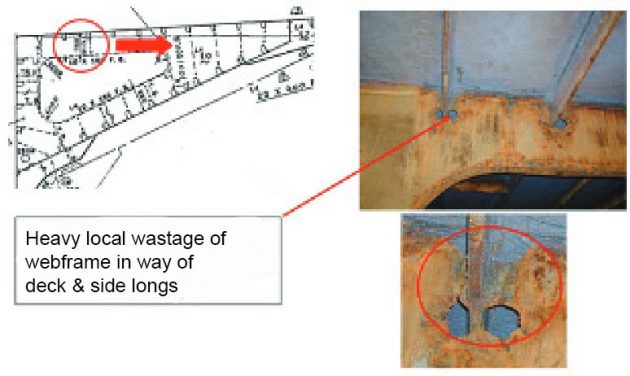
Technical managers, fleet managers and superintendents are target groups for these courses which can be conducted at the local DNV office or in the company’s offices.
This course has already been provided as in-house sessions for several of the major tanker owners throughout the international shipping community, such as:
- Piraeus;
- Dubai;
- Singapore;
- Kuala Lumpur;
- Hong Kong;
- Rio de Janeiro etc.
Other players in the shipping industry such as vetting inspectors, Flag State and Port State inspectors have also attended.
So far, more than 1 500 participants have received training through our courses, which consistently attain high ratings. The course is often referred to as “the missing link” between the theory which has long been taught in universities and marine training centres and the real world experienced during inspections.
Hull inspection course
Since the introduction of the ISM code, there have been requirements to owners carrying out regular inspections of ship’s hull and equipment. The crew is often responsible for carrying out such inspections.
It is, of course, of utmost importance that those given the responsibility of carrying out tank inspections actually possess the necessary knowledge/skills to do so. The quality of any inspection scheme is highly dependent on the qualifications of the inspectors.
DNV has therefore developed a course tailored to cover what is needed in order to carry out good hull inspections. The course has been developed by experienced naval architects/ships in operation surveyors and takes a basic, practical approach.
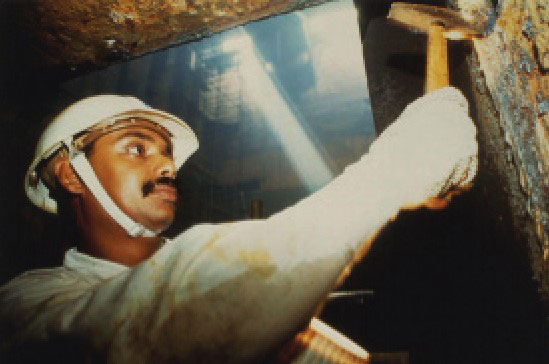
The course objective is to make sure that the participants know how to carry out a safe and efficient hull inspection and how to document the result.
Topics covered in the course include:
- Naming of ship structures.
- Introduction to hull strength theory.
- Preparation for inspection.
- Structural defects and coating deficiencies.
- Inspection and reporting skills.
The course lasts for one day and may be arranged in
connection with officer conferences. A computer-based training version of this course – Free Seagull CES questions and answers for marine specialistsCBT – has also been developed and may be supplied on board for refresher training.
Figure 9 Specific instructions on where to look, what to look for and how to report damages in the tank – 3D graphics and the real vessel
Some experiences shared from those companies that have attended this training:
- It contributes to retain valuable employees by showing that the company is willing to invest in their employee’s knowledge.
- Staffs are able to better understand the implications associated with hull damages and assess the risk.
- Operational risks are reduced with staff on board more readily able to assess hull structural condition at any given time.
Hull inspection manual
Apart from structural competence, systematic hull inspection and maintenance systems are essential to manage the hull integrity in a satisfactory manner.
In addition to providing training, DNV has since 2002 been heavily involved in helping owners to establish good systems for planned inspection and maintenance – delivered as ship type specific, company specific and vessel specific Hull Inspection Manuals.
Key elements of a good Hull Inspection Manual are the identification and listing of critical areas in need of special attention. To clearly illustrate these Areas of Attention (AoA), DNV uses the Nauticus 3D graphics to visualise in a way which is easy to understand also for non-naval architects. These 3D illustrations are often supplemented by details illustrated by drawings or photos. This gives a unique image description which makes the virtual reality very close to the real image on board, see Figure 10.
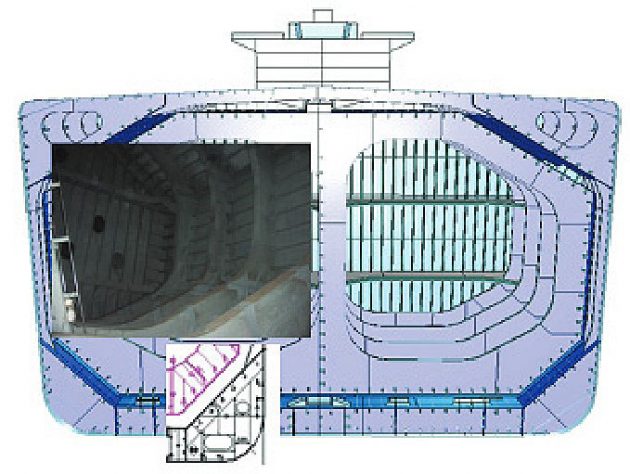
To identify the AoA, DNV’s broad general experience from the classed fleet is shared with the owners through hull experts dedicated to looking after ships in operation. This ensures that ship type critical areas are identified. In addition, we carry out a detailed scrutiny of the special details of each ship. Further, the detail level with regard to rating of coating condition, type of breakdown, how to report structural deficiencies etc. is tailored according to the needs of the company.
The manual itself is printed in colour in a handy pocket format in a water-resistant paper quality. The Hull Inspection Manual gives good support during owner’s inspections to identity critical areas and potential damage at an early stage and hence minimise the risk for incidents and off hire. The information regarding the condition of the different ships within a company is reported in a standardised format.
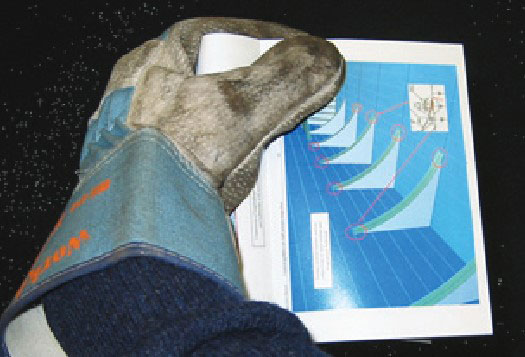
DNV has through the delivery of Hull Inspection Manuals to more than 150 vessels gained wide experience that future Hull Inspection Manuals will benefit from.
HullMan for LPG – Cargo tanks Type C
All tanks should be examined and inspected from inside and outside. Insulation may be required removed to the extent found necessary in order to:
- Inspect highly stressed parts of the tank from outside; foundations, horn of saddle, dome penetration attachments.
- Determine if the tank is corroded.
AoA on a LPG carrier with cargo tank type C normally include highly stressed areas such as (additional areas may relevant for individual designs and for vessels in special trade):
- Cargo tanks supports and anti-rolling anti-pitching devices.
- Stiffening rings including any doubling plates, webs and flanges.
- Y-connection between tank shell and a longitudinal bulkhead in bi-lobe tanks.
- Longitudinal bulkheads used in bi-lobe tanks. All crossing stiffeners. Termination of stiffeners. Knee plates. Edge of holes.
- Swash bulkhead boundaries. 3 main types:
- Supported by springs.
- Fixed to shell (hemispherical shape).
- Free floating i. e. free in radial direction supported in longitudinal direction.
- Dome and sump connections (with any doubling plates) to tank shell. Nozzles on domes.
- Foundations for pumps, towers, ladders etc.
- Pipe connections.
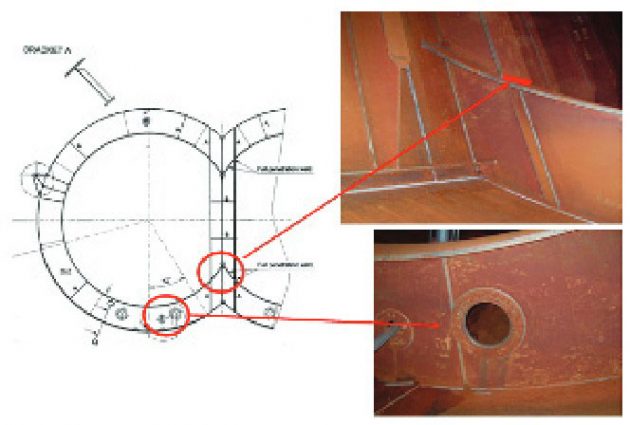
Another area of concern is damage of support wood. The wood may be swollen due to unsatisfactory control of moisture in hold space and wood not sufficiently resistant to the water, see Figure 13.
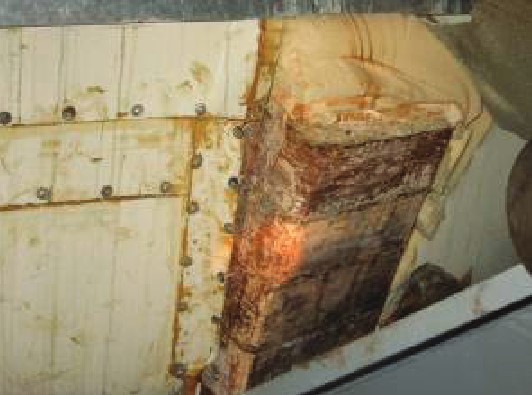
HullMan for LPG – Cargo tanks Type A
The cargo tank is part of a thorough analysis at the design/approval stage and the stress picture from such an analysis shows where the critical areas could be with respect to the cargo tank structure itself. AoA for inspections on a LPG carrier with cargo tank type A normally include (additional areas may relevant for individual designs and for vessels in special trade):
- Top plate of dome.
- Transverse bulkhead.
- Swash bulkhead.
- Horizontal stringers.
- Longitudinals.
- Catwalks.
- Ladders.
- Pump supports.
- Pipe supports.
Generally speaking, the inspection should concentrate on areas with stress risers due to structural details with increased stress concentration factor. Such details would be bracket toes, stringers toes, connection points of ladders etc.
In addition, the following areas are considered as highly stressed areas:
- Cargo tank supports and anti-rolling or anti-pitching devices;
- Web frames or stiffening rings.
- Swash bulkhead boundaries.
- Dome and sump connections to tank shell.
- Foundations for pumps, towers, ladders etc.
- Pipe connections.
The top plate of dome has several nozzle connections. These are critical locations that should be paid special attention. The top plate should also be inspected for corrosion.
Another area of attention is the area where brackets are connected to the end bulkhead. Here, the relative deflection in longitudinal direction is the highest.
Piping from pumps and pipes in general are fitted with clamps which again are welded to brackets connected with the cargo tank itself. If these clamps are too tight, vibrations or motions will be transferred to the brackets and we can have cracks in the connection between bracket and tank. Also for pump supports there is a flexible connection on the pump itself. If the connection is too tight, cracks can develop in the connections between the pump support and the tank.
Special attention is to be given to the cargo tank and insulation in way of chocks, supports and keys. Removal of insulation may be required in order to verify the condition of the tank or the insulation itself if found necessary. The most common cracks are in connection with anti rolling supports. The cracks normally propagate from the bracket connected to the tank top or deck, see Figure 14.
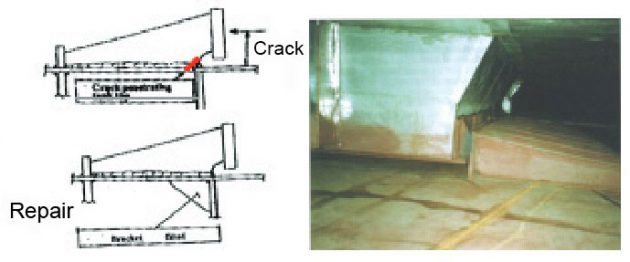
As far as practicable all hold spaces, secondary barriers and tank supporting structures are to be visually examined Inspections should include following (see also Figure 15):
- Visual examination of secondary barrier.
- Sealing arrangement at gas dome.
- Tank foundations.
- Knuckle points.
- Bilge arrangement.
- Instrumentation.
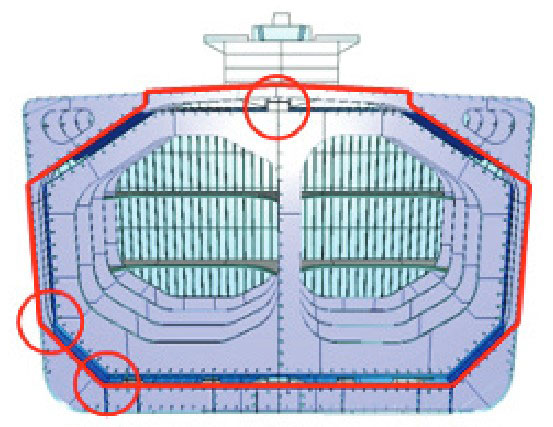
Nauticus hull integrity software
The hull inspection is not complete until the findings have been properly recorded. To recapture the value of time and knowledge invested in inspection activities, the findings should be used by both crew and onshore staff to control the condition of the vessel or fleet. To help capture this value in a structured, consistent and effective way, DNV offers the innovative maintenance support system – Nauticus Hull Integrity.
With Nauticus Hull Integrity, the crew takes advantage of graphical navigation aids supporting the inspection process. Inspections are carried out using predefined inspection data sheets which are structured in the same manner as the ship-specific Hull Inspection Manuals, ensuring transparent information capture which will help maximise reuse of the valuable findings. The crew’s inspection work process is supported by automatic transfer of inspection recordings to their central database onshore.
Nauticus Hull Integrity consists of an on board desktop application for planning and reporting of the hull condition, and a web-based onshore management system. The transfer of information between these two systems is managed by automated database updating via encrypted and compressed email messages.
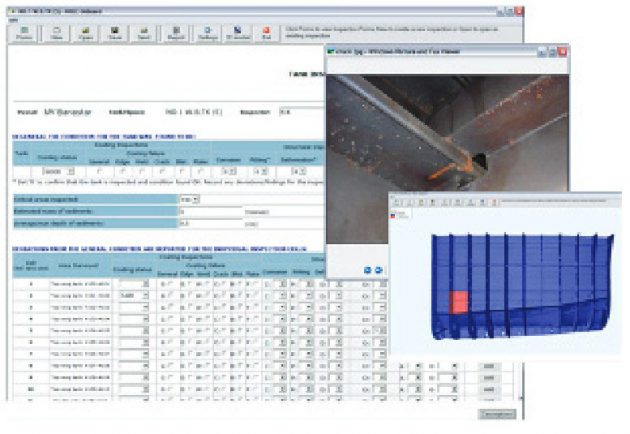
The onshore technical staffs use Nauticus Hull Integrity to analyse and document the vessel or fleet condition, and to prepare for repairs and dockings. An immediate condition control is enabled by colour-coded severity alarms displayed graphically on 2D tank plans and on 3D models for individual tanks.
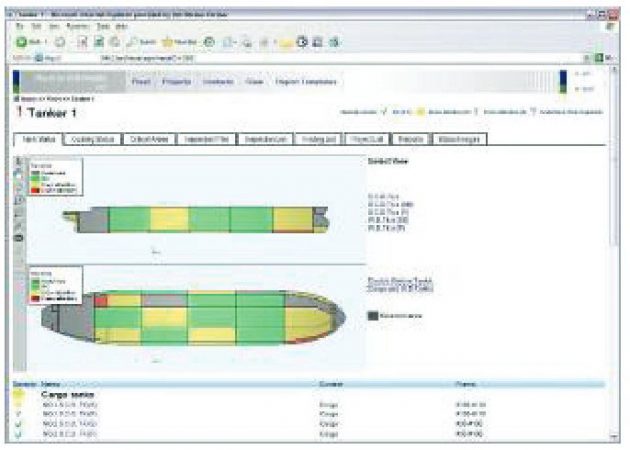
This facilitates a proactive maintenance environment where decision support is provided to superintendents and fleet managers, allowing them to quickly take action based on thorough and consistent ship and fleet condition data.
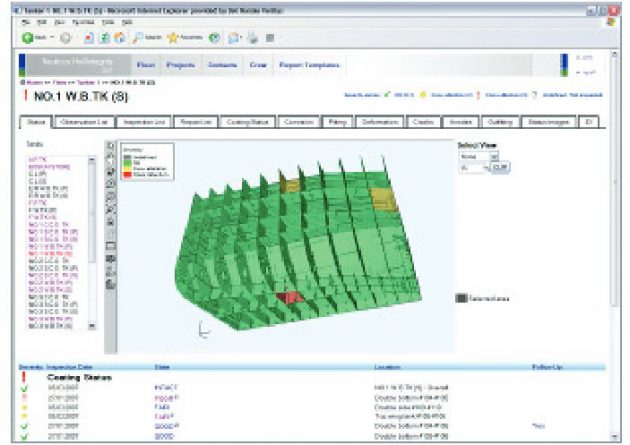
Experience so far has proved that the software is intuitive and easy to use, requiring only a minimum of training. Combined with training in hull structure and tank inspection, and the Hull Inspection Manuals, the software is part of a very powerful total concept enabling shipowners and operators to efficiently and effectively manage the hull integrity of their vessels.
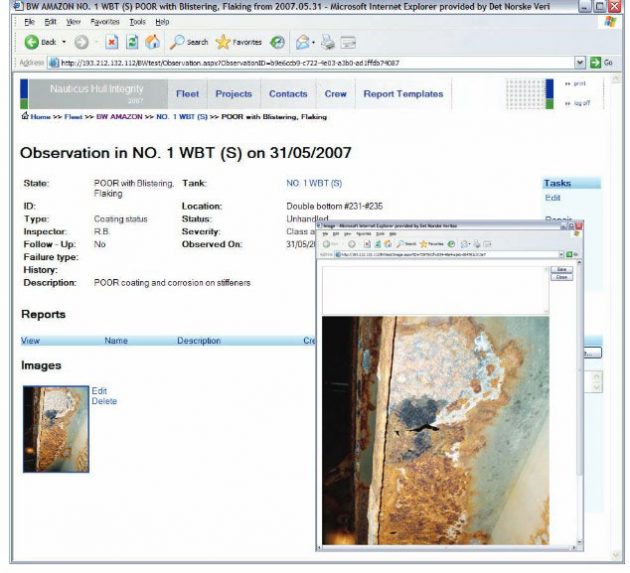
Hull advisory services
The last module of the Hull Integrity Management concept is a set of specialised Hull Advisory Services. These services are based on DNV’s extensive hull knowledge base and sophisticated tools for structural assessment using a comprehensive 3D graphical model of the vessel.
The services include:
- Steel renewal estimation and specifications.
- Coating renewal estimation and specifications.
- Docking specification and planning.
- Emergency repair specifications.
- Thickness measurements (UTM) guidelines, processing and maintenance planning.
- Feasibility of conversions from single to double hull.
Better control of the coating condition and steel diminution avoids corrosion on a big scale and contributes to the overall safety, as well as to cost efficiency. Following an incident, assistance with planning of repair activities can reduce off-hire time and costs. Experience with these services over many years clearly demonstrates that onshore and on board crew achieve much improved communication of the hull condition by utilising the Nauticus 3D technology.
Conclusion
In general, gas carriers have an excellent record in terms of safety. This shows that the classification standards and system of work have been capable of achieving the goal of safeguarding life, property and the environment. The role of the classification society as a resource and competence centre is perhaps of equal importance as the classification services.
Still, lack of satisfactory hull integrity may have basic negative consequences. This is also the reason why hull integrity receives such strong attention from charterers in connection with vetting. Excellent control of hull integrity is a hallmark of quality shipping.
DNV’s Hull Integrity Management (HIM) is a practical concept developed over a period of six years. It helps owners and operators in their in-service follow up, to keep their ship’s hull fit for purpose through continuous control of the hull condition. This may create business advantages and reduce the maintenance costs at the same time.
Based on DNV’s knowledge and hull expertise, Hull Integrity Management empowers your ship officers. It teaches them where to look and what to look for during regular on-board inspections. Hull Integrity Management helps in early detection of defects and to deal with problems while they are small.
For your technical staff, Hull Integrity Management will help them to be in control of the ship’s condition. Charterers notice better maintained vessels, maintenance costs drop, accident risk reduces and compliance with regulations and standards is easier to achieve. DNV’s hull expertise and procedures for planning and follow-up of inspections are combined with new easy-to-use Nauticus tools. This represents the proven innovation of DNV’s Hull Integrity Management.
Authors



